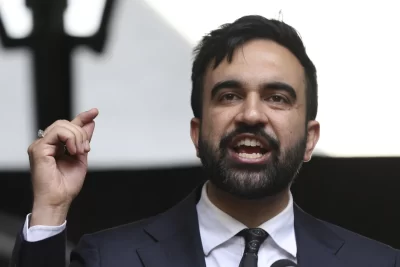
WINDSOR, Ontario — The busiest U.S.-Canada border crossing reopened late Sunday after protests against COVID-19 restrictions closed it for almost a week, while Canadian officials held back from a crackdown on a larger protest in the capital, Ottawa.
Detroit International Bridge Co. said in a statement that “the Ambassador Bridge is now fully open allowing the free flow of commerce between the Canada and US economies once again.” Esther Jentzen, spokeswoman for the company, said in a later text to The Associated Press that the bridge reopened to traffic at 11 p.m. EST.
The crossing normally carries 25% of all trade between the two countries, and the blockade on the Canadian side had disrupted business in both countries, with automakers forced to shut down several assembly plants.
Police in Windsor, Ontario, said earlier in the day that more than two dozen people had been peacefully arrested, seven vehicles towed and five seized as officers cleared the last demonstrators from near the bridge, which links the city — and numerous Canadian automotive plants — with Detroit.
A senior government official said Trudeau planned to meet virtually with the leaders of Canada’s provinces Monday morning. The official spoke on condition of anonymity as they were not authorized to speak publicly.
The Ambassador Bridge had remained closed for most of the day despite the break up of the protest as a heavy snowstorm blanketed the area. Windsor Mayor Drew Dilkens had said the span would open once authorities determined it was safe to do so.
Canada’s industry minister, François-Philippe Champagne, welcomed the development, saying on Twitter: “Good news. Glad to see that the Ambassador Bridge is now reopened.”
U.S. President Joe Biden’s administration on Sunday acknowledged the seemingly peaceful resolution to the demonstration, which it said had “widespread damaging impacts” on the “lives and livelihoods of people” on both sides of the border.
“We stand ready to support our Canadian partners wherever useful in order to ensure the restoration of the normal free flow of commerce can resume,” Homeland Security Advisor Dr. Liz Sherwood-Randall said in a statement.
In Ottawa, which is about 500 miles northeast of Windsor, Mayor Jim Watson said Sunday the city struck a deal with protesters who have jammed downtown streets for more than two weeks that will see them move out of residential areas in the next 24 hours.
The mayor shared a letter from one of the protest’s organizers, Tamara Lich, in which she said demonstrators “agree with your request” to focus activities at Parliament Hill. But Lich later denied there was an agreement, saying in a tweet: “No deal has been made. End the mandates, end the passports. That is why we are here.”
Watson added in his letter to protesters that residents are “exhausted″ and “on edge” due to the demonstrations and warns that some businesses are teetering on the brink of permanent closure because of the disruptions.
The ranks of protesters had swelled to what police said were 4,000 demonstrators by Saturday, and a counter-protest of frustrated Ottawa residents attempting to block the convoy of trucks from entering the downtown emerged Sunday.
Clayton Goodwin, a 45-year-old military veteran who was among the counter-protesters, said it was time for residents to stand up against the protesters.
“I’m horrified that other veterans would be down there co-opting my flag, co-opting my service,” said Goodwin, who is the CEO of the Veterans Accountability Commission, a nonprofit advocacy group. “It’s a grift. The city was free. We’re 92% vaccinated. We’re ready to support our businesses.”
Colleen Sinclair, another counter-protester, said the demonstrators have had enough time to have their discontent heard and need to move on — with police force, if it comes down to it.
“They’re occupiers. People are scared to go to work, too scared to leave their homes,” she said. “This is not how you get your voice heard. This is domestic terrorism and we want you out of our city. Go home.”
The city has seen similar expansions of the protest on past weekends, and loud music played as people milled about downtown where anti-vaccine demonstrators have been encamped since late January, to the frustration of local residents.
“It just feels like I’m living in a different country, like I’m in the States,” said Shannon Thomas, a 32-year-old teacher. “It just makes me really sad to see all these people waving Canadian flags and acting like patriots when it’s really the most sad and embarrassing thing I’ve ever seen.”
Trudeau has so far rejected calls to use the military, but had said that “all options are on the table” to end the protests. Trudeau has called the protesters a “fringe” of Canadian society. Both federal and provincial politicians have said they can’t order police what to do.
Major-General Steve Boivin, commander of Canadian Special Operations Forces Command, said Sunday that two of his special forces soldiers were supporting the protests in Ottawa and were in the “process of being released” from service. Boivin said the activity goes against the military’s values and ethics.
On Friday, a judge ordered an end to the blockade at the crossing in Windsor and Ontario Premier Doug Ford declared a state of emergency allowing for fines of 100,000 Canadian dollars and up to one year in jail for anyone illegally blocking roads, bridges, walkways and other critical infrastructure.
Partial closures at the bridge started on Feb. 7 and by midweek the disruption was so severe that automakers began shutting down or reducing production. The standoff came at a time when the industry is already struggling to maintain production in the face of pandemic-induced shortages of computer chips and other supply-chain disruptions.
“We are protesting the government taking away our rights,” said Windsor resident Eunice Lucas-Logan. “We want the restrictions removed. We have to wait to find out.”
The 67-year-old has been out supporting the protest for the past four days. She said she appreciated that police have been patient.
On the other side of the country, a major truck border crossing between Surrey, British Columbia, and Blaine, Washington, was closed Sunday, a day after Canadian authorities said a few vehicles had breached police barricades and a crowd entered the area by foot.
The Royal Canadian Mounted Police said Sunday afternoon four people had been arrested for “mischief” during the protest. Some people who stayed overnight had packed up and left, but the border crossing and roads in the area remained closed.
A border blockade that began in Coutts, Alberta, north of Sweet Grass, Montana, on Jan. 29 remained in place as well. Police issued more than 50 traffic tickets Saturday and continued issuing them Sunday, RCMP Cpl. Troy Savinkoff said.




